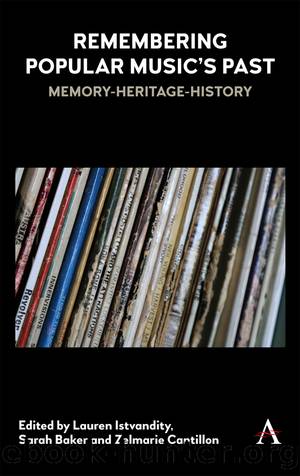Remembering Popular Musics Past by Istvandity Lauren.;Baker Sarah;Cantillon Zelmarie.;

Author:Istvandity, Lauren.;Baker, Sarah;Cantillon, Zelmarie.;
Language: eng
Format: epub
Publisher: Book Network Int'l Limited trading as NBN International (NBNi)
Riffs
It could be said that the large pop music history projects cited above, with their default rockist and mega-popist paradigms, were the product of their particular moment, and that that moment and that mode, characterized by a mood of celebratory discovery, has passed. But this too creates special opportunities for the scholarly researcherâstoryteller. Once the Big Pop, Big Rock models are dispensed with, the field is open for more targeted, more in-depth, more idiosyncratic enquiries: smaller histories, local histories, iconoclastic histories, histories of the unfashionable, explorations of music which are not defined and determined by conceptual parameters and commercial demands of the Music Industry.
Imagine an exhibition whose brief was to investigate the mediocre, the pretentious. Or the passionately pursued artistic dead-end. Or an investigation of the working lives and the actual financial returns of Australian musicians over the past century. A study of exploitation in music. And what of hacks: variety entertainers, cabaret singers, blue comedians and semi-inept magicians who made their living in the clubs of the 1960s and 1970s? What about queerness in popular music?
Much popular music research over the past three decades has been informed in one way or another by first-person agendas: researchersâ own past involvements in some scene or other â say 1970s pub rock, 1980s post-punk, 1990s dance cultures or whatever. The curator or interlocutor implicitly or explicitly draws authority in part from having been there as an adolescent or young adult in the pub, drinking the beer, taking the drugs, perhaps discovering their own particular identity.
And although lived and deeply felt involvements will no doubt remain a central feature of popular music research and retrospectivity, perhaps we have passed peak-first-person authenticity â I see the monumental indifference of my undergraduate music and arts writing students when they encounter yet another fond reminiscence about, say, Brisbane punk or 1980s Australian grunge. But the writerâcurator discovering a world to which she herself is a stranger or newcomer is one of the most compelling authorial devices possible â the auditor joins the author in the discovering, and that arc in turn often ends up providing the curator with a storytelling or explicatory structure. Itâs the non-nostalgia sensibility: itâs going to the past in search not of sameness, but of otherness, novelty, surprise.
Other tropes, such as the secret history, the unsung hero or telling the untold story, are virtually inexhaustible. There is always more to be told â but what if we omitted the heroic history-changing angle and simply tried to see the thing for what it was, even if that is something not of global importance?
Popular music studies has generally been sceptical of the biographical exploration of the âsignificant figureâ that orthodox musicology typically performs. But biography is a powerful narrative device, and if thoughtfully handled it can do much more than simply affirm the artistic genius of this or that particular artist. Biography can be judiciously used to shine light on habitus, on class and gender relations, on sexuality and cultural geography. Provided the storytelling
Download
This site does not store any files on its server. We only index and link to content provided by other sites. Please contact the content providers to delete copyright contents if any and email us, we'll remove relevant links or contents immediately.
The Goal (Off-Campus #4) by Elle Kennedy(12429)
Kathy Andrews Collection by Kathy Andrews(10516)
Diary of a Player by Brad Paisley(6866)
What Does This Button Do? by Bruce Dickinson(5525)
Assassin’s Fate by Robin Hobb(5235)
Big Little Lies by Liane Moriarty(4879)
Pale Blue Dot by Carl Sagan(4001)
Sticky Fingers by Joe Hagan(3453)
The Heroin Diaries by Nikki Sixx(2930)
The Death of the Heart by Elizabeth Bowen(2900)
Beneath These Shadows by Meghan March(2718)
The Help by Kathryn Stockett(2702)
Confessions of a Video Vixen by Karrine Steffans(2672)
How Music Works by David Byrne(2524)
Jam by Jam (epub)(2485)
Harry Potter 4 - Harry Potter and The Goblet of Fire by J.K.Rowling(2416)
Strange Fascination: David Bowie: The Definitive Story by David Buckley(2367)
Petty: The Biography by Warren Zanes(2236)
Darker Than the Deepest Sea by Trevor Dann(2206)
